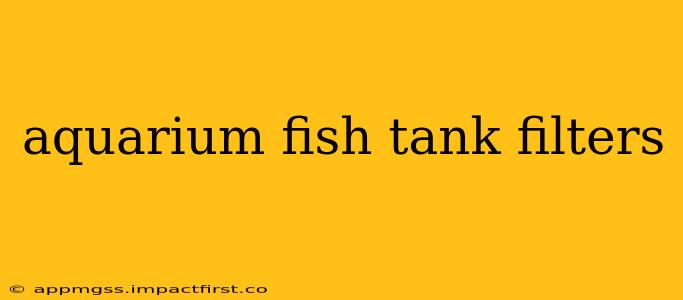Choosing the right filter for your aquarium is crucial for maintaining a healthy environment for your fish. A clean and well-oxygenated tank is essential for their wellbeing, and the filter plays a vital role in achieving this. This guide will delve into the different types of aquarium filters, their functionalities, and how to choose the best one for your needs. We'll also address some frequently asked questions to help you make an informed decision.
What are the Different Types of Aquarium Filters?
There are several types of aquarium filters available, each with its own advantages and disadvantages. The most common types include:
-
Hang-on-back (HOB) filters: These filters hang on the back of the aquarium, making them easy to install and maintain. They are suitable for most tank sizes and offer good filtration for a range of fish. They're generally affordable and a popular choice for beginners.
-
Undergravel filters (UGF): These filters work by drawing water through a gravel bed, where beneficial bacteria colonize and break down waste. While effective, they require careful maintenance and aren't as popular as other filter types due to their limitations in mechanical filtration.
-
Canister filters: These powerful filters sit outside the tank and use a series of chambers to filter the water. They provide superior filtration, particularly for larger tanks and more demanding aquatic life. They require more initial setup but offer excellent performance and are often preferred by experienced aquarists.
-
Internal filters: These submersible filters sit inside the tank, offering a discreet and easy-to-install solution. They're suitable for smaller tanks and offer decent filtration, but they may not be as powerful as other types.
-
Sponge filters: These simple and reliable filters use a porous sponge to trap debris. They are excellent for breeding tanks and are known for their quiet operation. They are less effective at mechanical filtration than other filter types.
How Often Should I Change My Aquarium Filter Media?
The frequency of filter media changes depends on several factors, including the type of filter, the size of your tank, and the number of fish you have. Generally, you should replace mechanical filter media (like filter pads or sponges) every few weeks, or as needed, when they become visibly clogged. Biological filter media (like ceramic rings or bio-balls), which houses beneficial bacteria crucial for water quality, should be cleaned less frequently – perhaps every few months or even less often. Never replace all the biological media at once, as this would wipe out your beneficial bacteria and destabilize the tank's ecosystem. Instead, clean or replace portions at a time.
What Size Filter Do I Need for My Aquarium?
The size of filter you need depends on the volume of water in your tank. Filter manufacturers usually provide specifications indicating the appropriate tank size for each filter model. Choosing a filter that is too small will lead to inadequate filtration, potentially resulting in poor water quality and harming your fish. Conversely, a filter that is too large may be overkill and unnecessary. Aim for a filter that is appropriately sized for your tank’s capacity.
How Do I Clean My Aquarium Filter?
Cleaning your aquarium filter is crucial for maintaining its effectiveness. Always rinse mechanical filter media (like sponges and filter pads) in old aquarium water, not tap water, to avoid removing beneficial bacteria. Avoid using soap or detergents, as these can be harmful to your fish. For biological media, you can simply rinse it gently to remove excess debris. Again, never clean or replace all biological media at once.
Can I Use a Filter for a Different Tank Size?
While it's possible to use a filter designed for a larger tank in a smaller tank (though it might be overkill), you generally shouldn't use a filter designed for a smaller tank in a larger one. Doing so will likely result in insufficient filtration for the larger volume of water. Always check the manufacturer's specifications to ensure compatibility with your aquarium's size and stocking levels.
What are the Signs of a Failing Aquarium Filter?
A failing filter can quickly compromise your tank's water quality. Signs of a failing filter include cloudy or murky water, a strong smell from the tank, increased algae growth, and changes in your fish’s behavior (such as lethargy or illness). If you notice any of these signs, inspect your filter immediately. Regular maintenance and prompt filter replacement or repair can prevent larger problems.
By understanding the different types of filters and how to maintain them, you can significantly improve the health and wellbeing of your aquarium inhabitants. Remember to choose the right size for your tank and always maintain it regularly. A well-functioning filter is the cornerstone of a thriving aquarium ecosystem.
